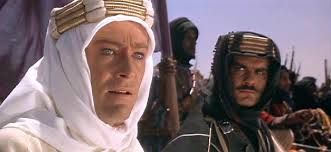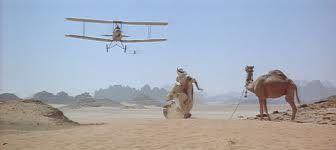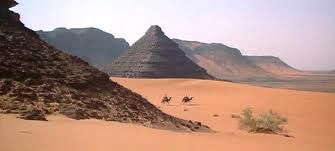David Lean's immense 1962 biographical film Lawrence of Arabia has been re-released in Blu-ray, and not before time. The splendid new digital transfer captures both its majesty and detail as no earlier video has done. It's a greater movie than I remembered it from the two earlier versions I saw, one in a theater and one as a VHS tape.
Technically this is about the best Blu-ray disc authoring that has ever come my way. On a decent home theater system, it probably boasts more natural color tones and sharper outlines than you would have seen in almost any movie theater on its original release -- and the sound is unquestionably upgraded. Of course it's in the original widescreen aspect ratio, probably 2.35 to 1.
One courageous thing David Lean did in Lawrence was being the first director to use the widescreen dimensions for something other than cast-of-thousands spectacle. Even the battle scenes are on a human scale, probably historically correct: the Arab tribal "armies" seem to number in the hundreds, or sometimes a few dozen.
Not that there isn't plenty of eye food. I won't bang on about the landscapes -- they're part of the movie's legend, sometimes imitated but never surpassed, and overpowering in Blu-ray. The atmosphere of the British headquarters in Cairo and Jerusalem is designed with loving care.
The script, credited to Robert Bolt and Michael Wilson, isn't afraid to settle down and explore the ambiguities of Lawrence's relationship with the British army command. The result is an artful blend of the psychological (at least on the British side -- the scenes with the Arabs are less convincing) and the emotionally stirring.
Another courageous act on Lean's part was casting Peter O'Toole, then unknown to movie audiences, in the lead of a very expensive picture. The financiers must have been sweating blood. O'Toole was brave as well. He has to fixate the camera in his aura for a good part of the three and a quarter hour running time (this edition; others have been re-cut in various ways), a daunting task for any actor.
In addition, he constantly risks being upstaged by distinguished character actors like Alec Guinness, Jack Hawkins, Claude Rains, and Jose Ferrer. (The last-named is pure genius. His portrayal of a sinister Turkish army officer who watches the beating of Lawrence and, presumably, later rapes him is unforgettably chilling. Yet on the surface he seems to be doing practically nothing. Well, as Larry Olivier said to Dustin Hoffman after Hoffman stayed up all night to play a character who'd been up all night, "Dear boy, it's called acting.")
Peter O'Toole rises to the occasion. It's a pleasure to see him before he developed an extremely high opinion of himself and drank his meals.
The rest of the cast lets the side down one way or another. Omar Sharif chews the scenery, infinite though it is, as an Arab tribal leader called Sherif Ali. There should have been a new Sherif in town. Anthony Quinn, as the head of an opposing tribe, plays his character brilliantly -- the trouble is, the character he plays is Anthony Quinn. Anthony Quayle, renowned English stage actor (I used to listen to records of him reading poetry), is curiously bland. As an American reporter following in Lawrence's dust and trying to write his legend, Arthur Kennedy is suffocatingly dull.
The journalistic subplot strikes me as the movie's only serious misstep. What are we supposed to infer from it? That the famous Lawrence was a creation of a newspaper hack? But the whole rest of the film illustrates quite the reverse.
Never mind. Lawrence of Arabia is a "great film" that actually is a great film. And at last it's presented in a format that allows its brilliance to be appreciated anew.






No comments:
Post a Comment